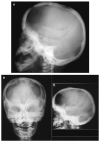LRP5, Bone Mass Polymorphisms and Skeletal Disorders
- PMID: 37895195
- PMCID: PMC10606254
- DOI: 10.3390/genes14101846
LRP5, Bone Mass Polymorphisms and Skeletal Disorders
Abstract
The formation and maintenance of the gross structure and microarchitecture of the human skeleton require the concerted functioning of a plethora of morphogenic signaling processes. Through recent discoveries in the field of genetics, numerous genotypic variants have been implicated in pathologic skeletal phenotypes and disorders arising from the disturbance of one or more of these processes. For example, total loss-of-function variants of LRP5 were found to be the cause of osteoporosis-pseudoglioma syndrome (OPPG). LRP5 encodes for the low-density lipoprotein receptor-related protein 5, a co-receptor in the canonical WNT-β-catenin signaling pathway and a crucial protein involved in the formation and maintenance of homeostasis of the human skeleton. Beyond OPPG, other partial loss-of-function variants of LRP5 have been found to be associated with other low bone mass phenotypes and disorders, while LRP5 gain-of-function variants have been implicated in high bone mass phenotypes. This review introduces the roles that LRP5 plays in skeletal morphogenesis and discusses some of the structural consequences that result from abnormalities in LRP5. A greater understanding of how the LRP5 receptor functions in bone and other body tissues could provide insights into a variety of pathologies and their potential treatments, from osteoporosis and a variety of skeletal abnormalities to congenital disorders that can lead to lifelong disabilities.
Keywords: LRP5; OPPG; high bone mass; low bone mass; low-density lipoprotein receptor-related protein 5; osteoporosis-pseudoglioma syndrome; skeletal dysmorphogenesis; skeletal phenotype.
Conflict of interest statement
The authors declare no conflict of interest.
Figures






References
-
- Online Mendelian Inheritance in Man, OMIM®. Johns Hopkins University, Baltimore, MD. MIM Number: 603506. [(accessed on 30 May 2023)]. Available online: https://www.omim.org/entry/603506.
-
- Online Mendelian Inheritance in Man, OMIM®. Johns Hopkins University, Baltimore, MD. MIM Number: 259770. [(accessed on 30 May 2023)]. Available online: https://www.omim.org/entry/259770.
-
- Little R.D., Folz C., Manning S.P., Swain P.M., Zhao S.-C., Eustace B., Lappe M.M., Spitzer L., Zweier S., Braunschweiger K., et al. A mutation in the LDL receptor-related protein 5 gene results in the autosomal dominant high-bone-mass trait. Am. J. Hum. Genet. 2002;70:11–19. doi: 10.1086/338450. - DOI - PMC - PubMed
-
- Karakilic-Ozturan E., Altunoglu U., Ozturk A.P., Al A.D.K., Abali Z.Y., Avci S., Wollnik B., Poyrazoglu S., Bas F., Uyguner Z.O., et al. Evaluation of growth, puberty, osteoporosis, and the response to long-term bisphosphonate therapy in four patients with osteoporosis-pseudoglioma syndrome. Am. J. Med. Genet. A. 2022;188:2061–2070. doi: 10.1002/ajmg.a.62742. - DOI - PubMed
Publication types
MeSH terms
Substances
Supplementary concepts
LinkOut - more resources
Full Text Sources
Medical

